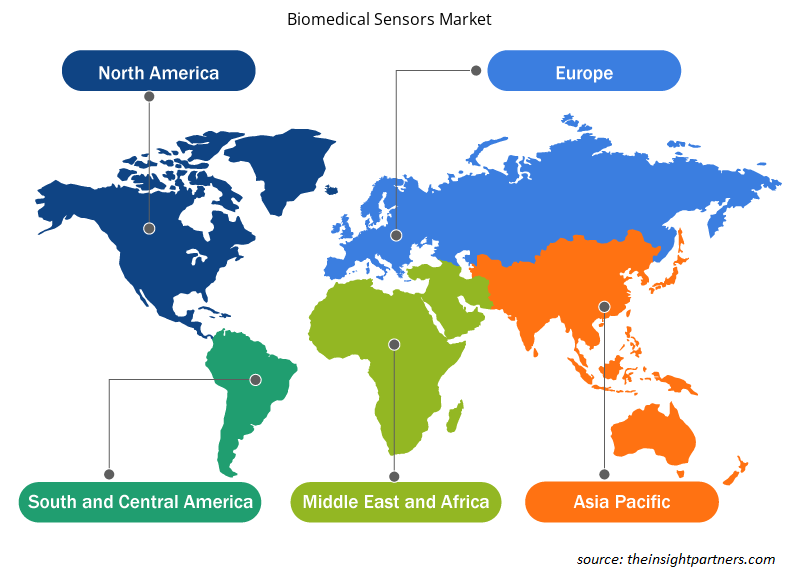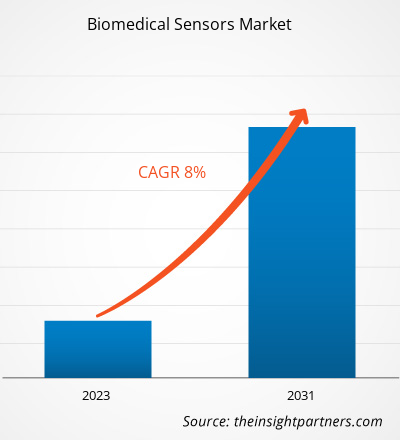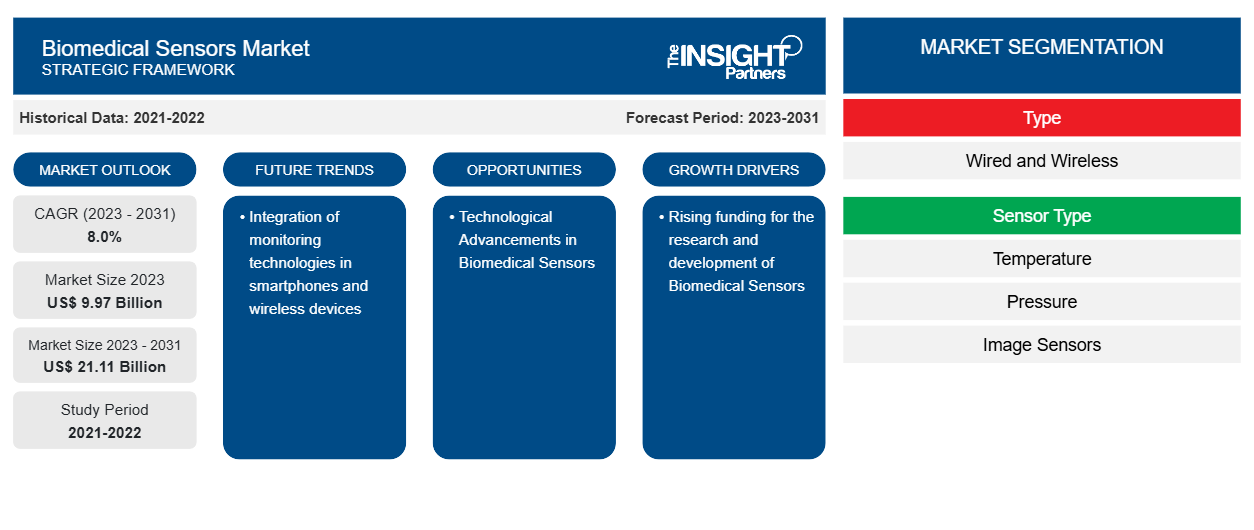La taille du marché des capteurs biomédicaux devrait passer de 9,97 milliards USD en 2023 à 21,11 milliards USD en 2031 ; le marché devrait enregistrer un TCAC de 8,0 % au cours de la période 2023-2031. L'intégration des technologies de surveillance dans les smartphones et les appareils sans fil est une tendance critique sur le marché des capteurs biomédicaux.
Analyse du marché des capteurs biomédicaux
De nombreuses organisations privées et gouvernementales collectent des fonds pour soutenir la recherche biomédicale. Le financement vise à faciliter la recherche collaborative entre les facultés des domaines biomédicaux et de l'ingénierie, en mettant l'accent sur le développement de dispositifs, de capteurs et de systèmes biomédicaux. En avril 2023, le projet de recherche SmartCare : HbA1c Self-Monitoring Technology, financé par le National Institute for Health Research (NiHR i4i Connect) avec une subvention d'une valeur de 186,7 millions de dollars américains, a été lancé avec pour objectif principal de valider expérimentalement un outil de diagnostic du diabète qui se concentre sur divers biomarqueurs sanguins. Le Dr Iasonas Triantis du Centre de recherche en ingénierie biomédicale de l'École des sciences et technologies a été nommé chercheur principal (PI) de l'étude. De même, en février 2024, la Fondation Novo Nordisk a généreusement accordé une subvention de 21,37 millions de dollars américains pour la création du Centre de Copenhague pour la détection quantique biomédicale. Avec cette initiative, le domaine des sciences biomédicales et de la santé est sur le point de subir une transformation majeure avec l'avènement de la technologie de détection quantique. Cette technologie de pointe promet de révolutionner le diagnostic et la prévention des maladies avec une précision sans précédent. Grâce à cette collaboration de recherche internationale, les scientifiques souhaitent développer de nouveaux principes et techniques de détection quantique qui peuvent être utilisés pour la détection précoce des maladies.
Aperçu du marché des capteurs biomédicaux
La croissance du marché des capteurs biomédicaux est attribuée à des facteurs tels que l'adoption croissante des dispositifs médicaux basés sur l'IoT, la demande croissante de soins médicaux à domicile, l'augmentation de la population gériatrique, les avancées technologiques dans l'industrie des dispositifs médicaux et l'augmentation des dépenses de santé à travers le monde. Le marché des capteurs biomédicaux est segmenté en Amérique du Nord, Europe, Asie-Pacifique, Moyen-Orient et Afrique, et Amérique du Sud et centrale. L'Amérique du Nord détient la plus grande part du marché, et l'Asie-Pacifique devrait enregistrer le TCAC le plus rapide au cours de la période 2023-2031. On estime que les États-Unis représentent la plus grande part du marché des capteurs biomédicaux. La croissance du marché aux États-Unis est attribuée aux efforts déployés par les principaux fournisseurs de capteurs biomédicaux pour établir leurs principales bases de fabrication, à l'augmentation de l'incidence des maladies aiguës et chroniques au sein de la population et aux avancées technologiques dans le secteur de la santé dans ce pays.IoT-based medical devices, burgeoning demand for home-based medical care, surging geriatric population, technological advancements in the medical device industry, and rising expenditure on healthcare across the world. The biomedical sensors market is segmented into North America, Europe, Asia Pacific, the Middle East & Africa, and South & Central America. North America holds the largest share of the market, and Asia Pacific is expected to record the fastest CAGR during 2023–2031. The US is estimated to account for the largest share of the biomedical sensors market. Market growth in the US is attributed to the efforts made by leading biomedical sensor vendors to establish their primary manufacturing bases, rising incidences of acute and chronic diseases among the population, and technological advancements in the healthcare sector in this country.
Personnalisez ce rapport en fonction de vos besoins
Vous bénéficierez d'une personnalisation gratuite de n'importe quel rapport, y compris de certaines parties de ce rapport, d'une analyse au niveau des pays, d'un pack de données Excel, ainsi que de superbes offres et réductions pour les start-ups et les universités.
-
Obtenez les principales tendances clés du marché de ce rapport.Cet échantillon GRATUIT comprendra une analyse de données, allant des tendances du marché aux estimations et prévisions.
Facteurs moteurs et opportunités du marché des capteurs biomédicaux
L'incidence croissante des maladies liées au mode de vie favorise le marché
Divers facteurs tels que le stress, l'obésité, la sédentarité, la malnutrition et la consommation de tabac et d'alcool contribuent à la prévalence croissante des maladies liées au mode de vie, notamment des maladies cardiovasculaires (MCV). Selon le rapport « Heart Disease and Stroke Statistics—2023 » de l'American Heart Association, les maladies coronariennes étaient la forme de maladie cardiaque la plus répandue en 2021, tuant 375 476 personnes cette année-là. On estime que près de 5 % des adultes âgés de 20 ans et plus souffrent de maladie coronarienne (MC). Par conséquent, avec l'incidence croissante des maladies liées au mode de vie, il existe un besoin accru de capteurs biomédicaux qui peuvent être utilisés pour une surveillance régulière de la santé. Les biocapteurs de MCV de pointe et la bioélectronique de surveillance introduits récemment, qu'ils soient portables ou implantables, ont permis la mesure continue des marqueurs cardiaques.CVDs). According to the "Heart Disease and Stroke Statistics—2023" report by the American Heart Association, coronary heart disease was the most prevalent form of heart disease in 2021, claiming the lives of 375,476 individuals that year. Nearly 5% of adults aged 20 and above are estimated to have CVD biosensors and monitoring bioelectronics introduced in the recent past, either wearable or implantable, have enabled the continuous measurement of cardiac markers.
Les avancées technologiques dans le domaine des capteurs biomédicaux devraient stimuler le marché à l'avenir
Les progrès technologiques dans le domaine des capteurs biomédicaux, avec l’intégration de la microtechnologie et de la nanotechnologie, ont permis l’introduction de capteurs compacts, robustes, innovants et économiques, adaptables à la constitution génétique de chaque individu. Ces capteurs sont configurés pour déclencher des alertes lorsqu’ils enregistrent des mesures imprévisibles, pour détecter la présence d’agents toxiques dans le sang et pour administrer des médicaments directement dans le système circulatoire. L’augmentation des investissements dans le développement et l’approbation réglementaire de ces capteurs avancés devrait stimuler le marché des capteurs biomédicaux dans les années à venir. En outre, les applications émergentes des capteurs biomédicaux dans le domaine de la nanotechnologie et les innovations continues conduisent au développement de procédures médicales avancées non invasives basées sur des capteurs. En février 20201, des chercheurs de Missouri S&T ont conçu un patch de détection d’oxygène imprimé sur un pansement flexible jetable qui peut être connecté à un smartphone. Ce pansement intelligent pourrait permettre une surveillance à distance pour la détection précoce de pathologies telles que les escarres, facilitant ainsi un traitement ou une intervention immédiate.
Analyse de segmentation du rapport sur le marché des capteurs biomédicaux
Les segments clés qui ont contribué à l’élaboration de l’analyse du marché des capteurs biomédicaux sont le type, le type de capteur, le produit et l’application.
- En fonction du type, le marché des capteurs biomédicaux est divisé en deux catégories : filaire et sans fil. Le segment sans fil détenait une part de marché plus importante en 2023.
- Par type de capteur, le marché est segmenté en capteurs de température, de pression, d'image, biochimiques, inertiels, de mouvement, d'électrocardiogramme et autres types de capteurs. Le segment de la température détenait la plus grande part du marché en 2023.
- En termes de produits, le marché est divisé en capteurs invasifs et capteurs non invasifs. Le segment des capteurs non invasifs détenait une part de marché plus importante en 2023.
- En fonction des applications, le marché est segmenté en diagnostic médical, thérapie clinique, imagerie et soins de santé personnels. Le segment du diagnostic médical détenait la plus grande part du marché en 2023.
Analyse des parts de marché des capteurs biomédicaux par géographie
La portée géographique du rapport sur le marché des capteurs biomédicaux est principalement divisée en cinq régions : Amérique du Nord, Asie-Pacifique, Europe, Moyen-Orient et Afrique, et Amérique du Sud et centrale. L'Amérique du Nord domine le marché mondial des capteurs biomédicaux. Selon l'Organisation mondiale de la santé (OMS), près de 30 millions de personnes souffrent d'un accident vasculaire cérébral chaque année. L'American Heart Association indique que plus de 130 millions de personnes aux États-Unis devraient souffrir d'un type de maladie cardiovasculaire (MCV) d'ici 2035. Ainsi, la prévalence croissante des MCV est attribuée à la domination de l'Amérique du Nord sur le marché mondial.
Aperçu régional du marché des capteurs biomédicaux
Les tendances et facteurs régionaux influençant le marché des capteurs biomédicaux tout au long de la période de prévision ont été expliqués en détail par les analystes d’Insight Partners. Cette section traite également des segments et de la géographie du marché des capteurs biomédicaux en Amérique du Nord, en Europe, en Asie-Pacifique, au Moyen-Orient et en Afrique, ainsi qu’en Amérique du Sud et en Amérique centrale.

- Obtenez les données régionales spécifiques au marché des capteurs biomédicaux
Portée du rapport sur le marché des capteurs biomédicaux
| Attribut de rapport | Détails |
|---|---|
| Taille du marché en 2023 | 9,97 milliards de dollars américains |
| Taille du marché d'ici 2031 | 21,11 milliards de dollars américains |
| Taux de croissance annuel composé mondial (2023-2031) | 8,0% |
| Données historiques | 2021-2022 |
| Période de prévision | 2023-2031 |
| Segments couverts |
Par type
|
| Régions et pays couverts |
Amérique du Nord
|
| Leaders du marché et profils d'entreprises clés |
|
Densité des acteurs du marché : comprendre son impact sur la dynamique des entreprises
Le marché des capteurs biomédicaux connaît une croissance rapide, tirée par la demande croissante des utilisateurs finaux en raison de facteurs tels que l'évolution des préférences des consommateurs, les avancées technologiques et une plus grande sensibilisation aux avantages du produit. À mesure que la demande augmente, les entreprises élargissent leurs offres, innovent pour répondre aux besoins des consommateurs et capitalisent sur les tendances émergentes, ce qui alimente davantage la croissance du marché.
La densité des acteurs du marché fait référence à la répartition des entreprises ou des sociétés opérant sur un marché ou un secteur particulier. Elle indique le nombre de concurrents (acteurs du marché) présents sur un marché donné par rapport à sa taille ou à sa valeur marchande totale.
Les principales entreprises opérant sur le marché des capteurs biomédicaux sont :
- Cognifit
- Santé de la mangue
- Bunchball
- Ayogo Santé Inc.
- Fitbit, Inc.
Avis de non-responsabilité : les sociétés répertoriées ci-dessus ne sont pas classées dans un ordre particulier.

- Obtenez un aperçu des principaux acteurs du marché des capteurs biomédicaux
Actualités et développements récents du marché des capteurs biomédicaux
Le marché des capteurs biomédicaux est évalué en collectant des données qualitatives et quantitatives après des recherches primaires et secondaires, qui comprennent d'importantes publications d'entreprise, des données d'association et des bases de données. Quelques-uns des développements clés du marché des capteurs biomédicaux sont répertoriés ci-dessous :
- Abbott a acquis Bigfoot Biomedical, une société spécialisée dans le développement de systèmes intelligents de gestion de l'insuline pour les personnes atteintes de diabète. Le système intelligent de gestion de l'insuline Bigfoot Unity développé par Bigfoot Biomedical utilise des capuchons de stylos à insuline connectés et ses opérations sont basées sur des données de surveillance continue intégrée de la glycémie (iCGM) et sur les instructions des prestataires de soins de santé. (Source : Abbott, communiqué de presse, 2023)
- Onera Health a lancé son premier laboratoire biomédical sur puce Onera. Le système de capteurs biomédicaux sur puce est conçu pour acquérir et traiter de multiples biosignaux et convient à une large gamme d'appareils de santé portables ainsi qu'à de nombreuses applications. Il offre de nombreuses solutions et opportunités d'innovation dans les secteurs de la médecine, du bien-être et du fitness. (Source : Onera Technologies BV, communiqué de presse, 2022)
Rapport sur le marché des capteurs biomédicaux : couverture et livrables
Le rapport « Taille et prévisions du marché des capteurs biomédicaux (2021-2031) » fournit une analyse détaillée du marché couvrant les domaines ci-dessous :
- Taille et prévisions du marché des capteurs biomédicaux aux niveaux mondial, régional et national pour tous les segments de marché clés couverts par le périmètre
- Tendances du marché des capteurs biomédicaux ainsi que dynamique du marché telles que les moteurs, les contraintes et les opportunités clés
- Analyse détaillée des cinq forces de PEST/Porter et SWOT
- Analyse du marché des capteurs biomédicaux couvrant les principales tendances du marché, le cadre mondial et régional, les principaux acteurs, les réglementations et les développements récents du marché
- Analyse du paysage industriel et de la concurrence couvrant la concentration du marché, l'analyse de la carte thermique, les principaux acteurs et les développements récents sur le marché des capteurs biomédicaux
- Profils d'entreprise détaillés
- Analyse historique (2 ans), année de base, prévision (7 ans) avec TCAC
- Analyse PEST et SWOT
- Taille du marché Valeur / Volume - Mondial, Régional, Pays
- Industrie et paysage concurrentiel
- Ensemble de données Excel
Rapports récents
Rapports connexes
Témoignages
Raison d'acheter
- Prise de décision éclairée
- Compréhension de la dynamique du marché
- Analyse concurrentielle
- Connaissances clients
- Prévisions de marché
- Atténuation des risques
- Planification stratégique
- Justification des investissements
- Identification des marchés émergents
- Amélioration des stratégies marketing
- Amélioration de l'efficacité opérationnelle
- Alignement sur les tendances réglementaires























 Obtenez un échantillon gratuit pour - Marché des capteurs biomédicaux
Obtenez un échantillon gratuit pour - Marché des capteurs biomédicaux